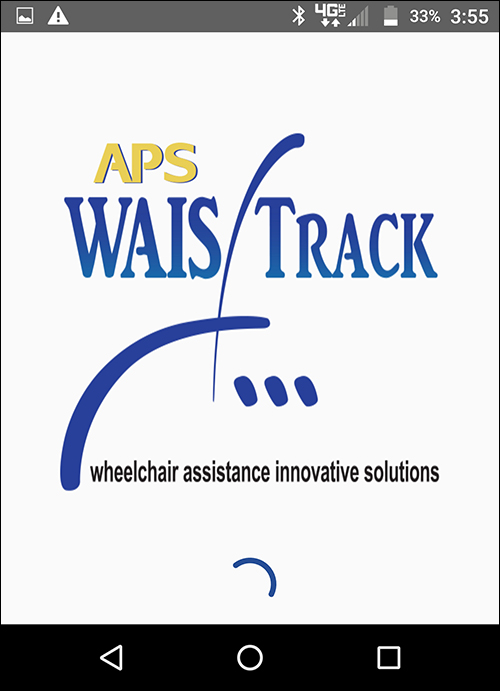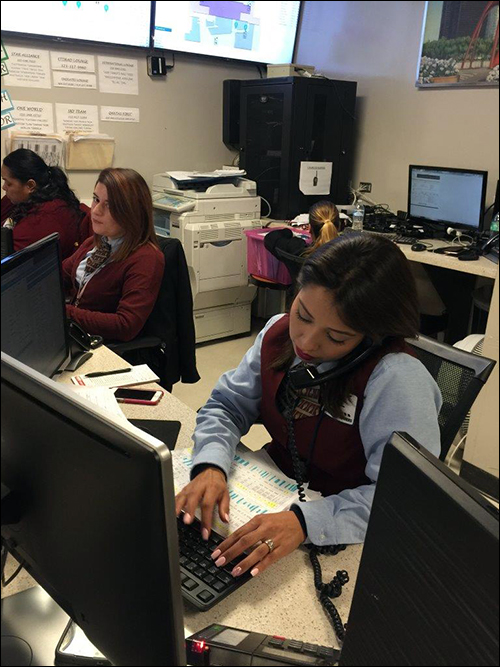The Los Angeles International Airport (LAX) is preparing the permanent deployment of Bluetooth Low Energy (BLE) beacon-based technology at its Tom Bradley International Terminal (TBIT), to manage wheelchairs as they are dispatched and used to transport passengers. The Wheelchair Assistance Innovative Solutions Tracking System (WAIS-Track), provided by Aero Port Services (APS), has reduced passenger wheelchair service times by about 50 percent since it was installed for testing several months ago, the company reports.
The system consists of Gimbal beacons deployed around the international terminal, Android-based smart devices carried by wheelchair agents, and the WAIS-Track app and content-management software to identify each agent’s location and, therefore, the status of services being provided to passengers.
LAX is the seventh busiest airport in the world and the third busiest in the United States, serving approximately 75 million passengers annually. APS, located in Inglewood, Calif., has provided wheelchair services throughout the airport for 14 years, says Iliana Thomas, Aero Port Services’ director of business development and legal affairs.
That service includes coverage at TBIT, where 38 foreign air carriers transport passengers into and out of the airport. The need for wheelchairs has been growing exponentially. In 2015, there were 970,000 wheelchair requests throughout the airport, the majority of which (275,000) were made at TBIT. That number is expected to be 14 percent higher this year, the company reports—approximately 325,000 at TBIT alone. (LAX is anticipated to exceed one million requests throughout the year.)
To address all of these wheelchair requests, five to six APS dispatchers in a control center at the terminal manage the movements of about 200 agents who transport passengers with a wheelchair to and from gates. The dispatchers have traditionally alerted agents about service requests via walkie-talkie or cell phone, or when the agents report to the control center; it can take several minutes for an agent with a wheelchair to arrive at the gate to which he or she is being summoned.
Agents also had to carry paperwork, and once they reached the passenger, they had to fill out a form indicating that individual’s identity, as well as when and where they were picked up and dropped off. The paperwork then had to be signed by the agent and by an airline employee. In the meantime, if the passenger was delayed at customs or another location, Aero Port (without the beacon technology) had little way of immediately knowing where the agent and passenger were, or why they were delayed. That meant the airlines ‘could not keep the passengers’ friends or family members informed’.
Now, APS is using its proprietary software and an app developed by Antikythera Technologies, of Beverly Hills, to eliminate the need for paperwork, automatically request a pick-up from the closest unoccupied agent, and provide real-time visibility into the passenger’s and agent’s locations throughout the terminal. About two years ago, Thomas says, “We contacted the software-development company because we wanted the ability to respond to requests automatically with the person closest to that request.” This, he adds, reduced the amount of time agents had to spend going to the dispatch center or walking further when closer agents would have been available.
This fall, APS installed around 100 beacons throughout most of the terminal. In addition, the company provided beacon-enabled Android smart devices to a select number of agents.
First, a passenger requests wheelchair service from his or her airline when booking a flight. The airline reports the need for that wheelchair when the flight arrives at the TBIT terminal (or when an outbound passenger arrives at the airport requiring help to get to the gate). APS dispatchers receive the request and, with the WAIS-Track system, view the location and status of each wheelchair agent throughout the terminal. That location data is captured and transmitted by the agent’s’ smart devices, which read beacon transmissions and forward that data to the content-management software on APS’s server, via the WAIS-Track app.
The dispatcher identifies the closest unoccupied agent and forwards to him or her details about the passenger in need of a wheelchair. That agent receives the alert, presses a prompt to respond and proceeds to the traveler’s location. The system then updates that agent’s status as occupied, so that no further dispatch requests will be received. The agent uses his or her Android device, running the WAIS-Track app, to scan the bar code on the passenger’s boarding pass, or manually inputs the passenger’s name into the system, then begins transporting the passenger to that person’s destination.
Throughout the transporting process, APS dispatchers can view where a particular agent is, and thus know the passenger’s location as well. The airline can also access that data, so if a family member were looking for a loved one soon to arrive in a wheelchair, he or she could go to the airline’s help desk, where an employee could access the APS system to determine where the wheelchair agent associated with that specific passenger was—for example, in the customs area. That information would be paired with the average wait time at customs for that time and day, so the airline could inform the family member how long to expect to wait.
Additionally, the airline can use the data if a passenger is missing at the time of boarding. If, for instance, the APS software indicates that the wheelchair agent for that passenger is approaching the gate, or is still waiting in the security area, the airline can make a decision about whether or not to hold the flight.
Since the system was installed for its testing phase earlier this year, Thomas says, the process has become more efficient than it was with the manual dispatching process. “We’ve been able to cut down the time it takes to respond to each request,” she explains, from an average of 15 to 20 minutes to only about seven minutes. “At the beginning, agents were timid about using it. “”But it’s very user-friendly. They don’t need to fill out paper orders, and they don’t need to record times. I think they’ve found that it makes their jobs easier.”
The system also enables APS to offer an incentive program to reward agents who are highly efficient. Upon finishing a shift, an agent can view how many passengers he or she served, for instance, in comparison to average numbers.
In January, APS plans to equip all of its 200 agents with the smart devices, and to install about 15 more beacons in order to provide full coverage at TBIT. LAX airlines are currently in conversation with APS about expanding the system’s use next year to other terminals throughout the airport. In that way, airlines or the airport staff could not only view when a passenger is in the TBIT terminal, but continue to monitor that individual’s progress in other areas of the airport.
For the airport, it’s all about efficiency for wheelchair-using passengers, according to Frederick Badlissi, the public information officer for Los Angeles World Airports, which oversees operations at LAX and Van Nuys Airport. “The main benefit is for improvements in response times for travelers requesting wheelchairs,” he says, “and improved communications and operational efficiency for the system’s operator, APS.” He adds, “We’re encouraged by the prospect of reducing wait times and enhancing the guest experience with the help of this cutting-edge technology, and look forward to the results of the system’s initial use.”




